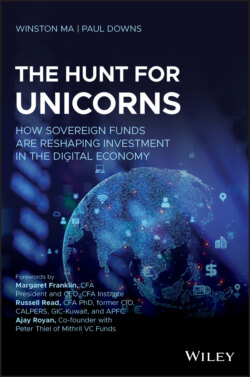Читать книгу The Hunt for Unicorns - Winston Ma - Страница 33
Talk vs. Walk
ОглавлениеThere are two main approaches that institutional investors deploy when they seek to influence the strategies of their portfolio companies. To achieve environmental, social, and governance (ESG) aims, for example, they may remain as shareholders and engage with the top management and boards of such companies in order to reduce emissions (the “talk” channel). Or, they can “vote with their feet,” by divesting polluting companies from their portfolio (the “walk” channel).
NBIM is well positioned for active engagement with public companies' management. By most accounts, its $1 trillion plus portfolio holds, on average, 1.5% of every listed company on Earth. NBIM's latest report on responsible investing released in March 2020, covering its 2019 voting, engagement with management, and follow up, runs to over 100 pages. Of the more than 9,000 companies in which it holds voting shares, NBIM cast votes in more than 97%, and it was not shy about voting against management even in its top holdings, such as Google, Amazon, and Facebook.
For climate change, NBIM has exercised both options: on the one hand engaging with companies developing strong decarbonization strategies; and on the other hand, divesting from heavy polluters like coal and fossil fuel companies. An ongoing and intriguing debate among SIF investors is whether it is better to divest, or better to engage. In practice, many SIFs use both channels and typically start with “talk.”
Arguably, both strategies can be effective, and they can interact with each other, as the threat of “walk” can reinforce the influence of “talk.” And sometimes the line is quite nebulous. “It's easy to have a slogan,” said Raphael Arndt, the Australia Future Fund's Chief Investment Officer. “But if someone says, ‘Get rid of fossil fuel companies', do I sell AGL? That's also my biggest exposure to renewables.”
Their size alone means that their actions, collectively and even individually, can have material impacts even when the intent is simply prudent management. For example, Norway's fund holds, on average, 1.5% of every listed company on earth, making it an investor that boards around the globe must heed (see Box: Talk vs. Walk). Japan's GPIF, the world's largest pension fund, was fingered by financial journalists as the mover behind an unexpected drop in the value of the yen. The action by GPIF to rebalance its portfolio in favor of more non-Japanese investments was enough to change the course of the $6 trillion daily volume of the foreign exchange markets. Wherever these giants turn their gaze, the impact is felt.
Their rise is taking place at a time when governments become ever more active players in markets across the board. This chapter surveys the universe of sovereign investors from a comparative political economy perspective. We will introduce their little-known enormous capital power for global investments, looking at how each is cast in a role, and how many have responded to the crisis of today, those of the past, and are anticipating those of the future.
